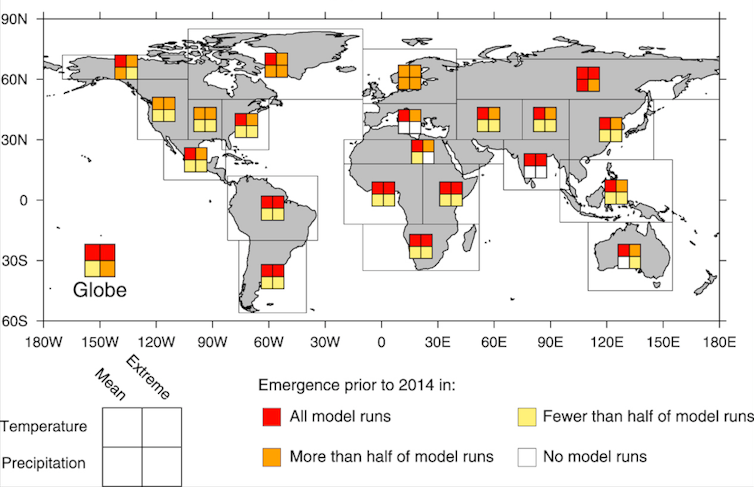Over the past century our climate has changed as greenhouse gas concentrations in the atmosphere have increased. Today we see the impacts of climate change in increasing numbers of extreme heat records while cold records decline, as well as in rising sea levels, the disappearance of land-based ice, and a host of other phenomena.
It is through these multiple lines of evidence that a scientific consensus has emerged telling us the impacts of climate change are not just a problem for the future – they have already arrived. But the question remains: at what point over the past century did climate change first make its presence felt?
Our new study goes some way to answering this question. Using state-of-the-art climate models, we and our colleagues investigated the statistical properties of temperatures and precipitation to see if they have been radically altered by climate change and, if so, when this disruption became evident. We focused on extremes in climate, as these can have large impacts on society and ecosystems.
We call the point in time when the human influence on climate becomes clear the “time of anthropogenic emergence”.
Climate scientists have long expected to see the earliest detectable evidence of the influence of climate change in temperatures. By contrast, increases in rainfall extremes driven by climate change are expected, but it has been difficult to determine when they would appear.
The results of our study were intriguing. For temperature extremes, we found that the earliest simulated emergence occurred in the tropics in the mid-to-late 20th century, generally from 1960 onwards. This is because there is less year-to-year variation in temperature extremes near the equator than at higher latitudes, so less warming is required before the human fingerprint becomes clear.
The models suggested that the impact on average temperatures appeared even earlier in some regions of Africa and in the Pacific nations north of Australia, first becoming apparent in the 1940s.
As flora and fauna in this region are adapted to a narrow range of temperatures, even a small amount of warming can have large impacts.
Closer to the poles, the time of anthropogenic emergence arrived later. In terms of average temperatures, most countries show clear climate change impacts today, although parts of the United States and Russia are only seeing their first clear indications this decade.
Still waiting for the rain to change
Interestingly, our models showed that the emergence of a human fingerprint on precipitation extremes has not happened yet. But there are indications that it will emerge in winter over much of Russia, Canada and Northern Europe during this decade and the next.

To ensure confidence in our findings, we tested them using several climate models and simulations.
There was strong agreement that the fingerprint in both average and extreme temperatures has already emerged across the globe. Fewer models indicated that a clearly discernible climate signal had emerged in heavy precipitation up to 2014, although there was a simulated increase in such events.
In summary, our analysis suggests that a human fingerprint on temperature extremes has already emerged and that it appeared in equatorial regions first. We can expect the effects of human-induced climate change on winter precipitation extremes in mid-to-high northerly latitudes to become clear soon, with an increase in the intensity of heavy precipitation days expected.
This work shows where the effects of human-induced climate change are being felt earliest. This provides a guide to where adaptation to climate change is needed. Of course, risk exposure to climate change impacts is made up of multiple factors including the ability to adapt to the change, as well as the relative magnitude of the change in the climate.
The tropics, where the earliest effects of climate change on temperatures seem to have occurred, also tend to be less economically developed and have less capability to adapt to climate change. These countries may require assistance in adapting to the warmer climate they are already experiencing.

